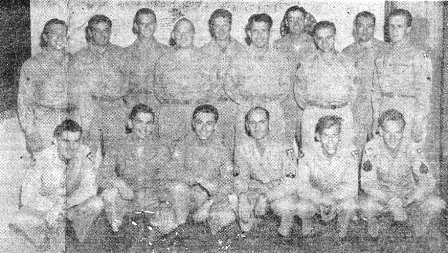
VOL. II NO. 7 REG NO. L5015 DELHI, FRIDAY OCTOBER 29, 1943.

|
All the top brass in the C.B.I. Theater, including some especially imported for the occasion from Washington and elsewhere, met in Chungking this week in a five-day conference whose import was as well understood in Tokyo as in Washington, London, or Delhi.
The occasion was the first meeting of Lord Louis Mountbatten, supreme commander of the Southeast Asia Command and generalissimo Chiang Kai-shek, President and military leader of China. Others who attended were Lt. Gen. Joseph W. Stilwell, commander of American forces in the C.B.I. Theater, Lt. Gen. Brehon Somervell, commanding general, Services of Supply, from Washington and Maj. Gen. George A. Stratemeyer, Commander of the USAAF of India and Burma and air advisor to Stilwell.
Mountbatten took with him his political advisor, John Keswich and was met in Chungking by Maj. Gen. Gordon Grimsdale, head of the British military mission to the Chinese government.
After preliminary discussions with Gen. Ho Yung Ching, Chinese Minister of War, Mountbatten proceeded to Chiang Kai-shek's summer bungalow in the Szechuan hills, where he spent two nights before his return to Delhi.
Authoritative quarters announce that the visit was "very successful," that satisfactory results have been achieved, and that a "most cordial atmosphere" marked all the conversations.
Meanwhile, from London came the news that Brig. Robert Edward Laycock, 56, of the Royal Horse Guards, has been appointed to Mountbatten's old job of Chief of Combined Operations, commanding Britain's famous commandos. Laycock is described as "tall, broad and tough," in which he resembles his predecessor.
|
Support To Chinese Infantry
HEADQUARTERS 14TH USAAF - Continued bombing of Japanese installations at Cobi, in French Indo-China and on the Salween front have been the missions of the 14th Air Force, according to the only communiqu issued from 14th Headquarters this week. Although some anti-aircraft fire was encountered, all of the planes returned safely to their base.
On Oct. 24, Liberators, with fighter escort, attacked Jap installations and barracks at Cobi. Twenty-five tons of bombs were dropped with successful results.
On another flight, B-24's carried out a successful mission in support of the Chinese troops on the Salween Front when they dropped many bombs on Japanese installations at Htawgaw.
10TH AF HOLDS MERRY PACE
GIVING JAPS HELL IN BURMA
Jap installations in Burma got another healthy going-over this week as bombers and fighters of the 10th Air Force continued to work out steadily on airfields, supply centers and communications. Results of virtually all missions were judged excellent, and operations for the entire seven days cost only one plane.
The Myitkyina area took the worst beating, good weather helping the boys to blast away at the runways, dispersal areas and railway centers. The enemy put up little opposition except after one mission at Heho, on Oct. 18, when a Liberator group sparred with seven Zeros for forty minutes, knocking off one definitely, probably disposing of another and damaging several more.
Mitchells started off the week by pounding away at the Myitkyina landing ground with excellent results. All of the bombs were in the target area and at least a third of the runway was destroyed. Others attacked river shipping at Bhamo, scoring several near misses on one large vessel, while the Liberators went to work on the airdrome at Heho, 95 miles southeast of Mandalay. Fragmentation bombs landed on the south runway and probably also damaged aircraft there, although clouds made observation difficult.
The next day Mitchells hit the air field at Hawlin, 45 miles southwest of Katha, landing all bombs in the target area and scoring several direct hits on the runway and dispersal area. Other formations ruined considerable trackage and rolling stock at Wuntho, north of Kawlin.
BRIDGES BOMBED
On Oct. 20 and 21 the Myitkyina area took it again. The first day Liberators destroyed main line tracks and sidings at Kanbalu, between Mandalay and Mogaung, while Mitchells gave it to the Meza River railroad bridge, 15 miles south of Naba Junction, and in conjunction with fighter-bombers, the Loilaw Bridge, severely damaging the center spans of each. The fighter-bombers also went to work at Kamaing, leaving several fires burning, and then strafed rolling stock at Sahmaw and Hopin.
The next day Mitchells destroyed considerable trackage and rolling stock and adjacent storage buildings at Mogaung, and hacked away again at the Myitkyina field. Liberators bombed railway yards and river shipping facilities at Myingyan with excellent results.
The B-25's shifted their activities on Oct.22 to the storage area at Alon, north of Monywa, leveling several buildings, leaving others burning, and destroying some rolling stock. Other formations scored several direct hits on the approaches of the Mu Canal bridge, east of Mandalay, and Liberators struck the Prome railway yards, with all bombs hitting the target area.
BRIDGE STRADDLED
On Oct. 23 the Mitchells were back at the Meza River railway bridge and straddled the target, while Liberators visited the railway yards at Kanbalu, 90 miles north of Mandalay and did heavy damage, two direct hits on an engine shed resulting in a large explosion. Fighter-bombers and mediums made a wide sweep over northern Burma, doing considerable damage at Manywet, the Loilaw Bridge, Sharaw Ga, Taipha and Kantau, 70 miles west of Sumprabum, and at Lonkin, 70 miles west of Myitkyina, where a large building was demolished and fires were left burning in the barracks area and other buildings.
Mitchells rounded out the week on Oct. 24 with an attack on Pintha, on the Burma railroad 100 miles north of Mandalay. The station and three storage buildings were strafed and considerable trackage was destroyed. Other formations attacked Ye-U, 70 miles northwest of Mandalay, leveling two storehouses, leaving several others in flames, and destroying considerable rolling stock and trackage.
This photo by Bob Bryant, INP photographer in China, shows what you see from a worm's-eye position when you're caught in the middle of an airfield during a bombing raid. The Japanese radio, after the raid, claimed that the field had been "rendered unusable for weeks to come" and many of our planes had been destroyed on the ground. This picture gives them the lie. The arrows point to Jap bomb bursts, plainly well off the airfield, and inside the circle are the leaping flames from the only U.S. plane hit. For full details of how this remarkable photograph was taken, we print below the letter to the Roundup which accompanied the picture.

By BOB BRYANT INP Photographer
CHINA AIR BASE - Well, finally, here is a bombing pix out of China.
After chasing from airbase to airbase trying to catch some action films the Japs came to me back here at headquarters - and damn near literally dumped it into my lap.
The Army was talking about putting me before a medical board for a Section Eight when they found I was strolling down the runway when the bombs fell. For your information, China hasn't got me quite that bad, mentally, yet. My being there by my lonesome then was just the result of taking somebody's word that the ching pao was over.
I left my tin hat and hillside position to go down to the field to get pix of our fighters landing, after "that somebody" said they were on the way in, and I got to the center of the field just as a second wave of Jap bombers struck. Thanks to the way our fighters jumped the bombers, it worked out fine - but that's sure the worst feeling I ever had. To hear the droning of approaching planes and then suddenly recognize that it's that peculiar, throbbing drone of Jap engines and not ours, when you're in the center of the runway of a flat, level airfield. Even the closest ditch 300 yards away and nothing but parked airplanes - their target - to hide behind.
I did some fancy running for about 60 seconds, until the first bomb burst and then hit the ground, stretching out on my belly, hiding behind blades of grass 30 feet from the runway strip. Col. Eugene Beebe, commanding the American bombers here, says it was a good thing it wasn't his boys up there bombing or there wouldn't have been enough left of the camera and negatives for anyone to ever gather anything up to develop - to say nothing of me. Anyway, I got the picture.
The payoff was that after the last stick of bombs hit and I was running again in case they made a second and more accurate run, a burst of more slugs from the fight above the clouds came pecking down into the ground 100 feet away. That would have done it - missed by the Jap bombs and then hit my the machine gun slugs of your own fighters.
Everybody rubs me on the head for luck around here now. Several weeks ago I started to go on two different bombing missions with the B-25's. Both times, after I was assigned to a ship and ready to go, something happened to make me stay behind. On the first mission, the plane I would have been riding in was shot down over Hankow. On the second trip, the plane I would have been in was hit and blew up over the target.
This hunk of war out here is beginning to get awfully personal. Bob.
|
He was wounded on the Arakan front Feb. 2, 1943, when a Jap sniper drew a bead on his ample behind and lodged therein an explosive bullet. The presentation was made at a quiet ceremony in the Roundup office and the following strictly Unofficial citation was read:
"Walter Briggs, United Press War Correspondent, did valiantly expose his rear to enemy fire while covering the Arakan campaign with camera and typewriter. An enemy sniper from a range of 600 yards shot Walter Briggs in the rotundum with an explosive bullet.
"Tokyo radio expressed the official view a few days later that a marksmanship medal would have been awarded to the sniper but for the fact the target was above regulation size.
"Walter Briggs was removed to a British Military Hospital where without complaint he underwent an operation on his posterior and sat for many days thereafter on an inflated doughnut.
"The victim has now returned to duty and covers the battle of Per Diem Hill with typewriter, camera and the same doughnut.
"It is believed that this is the first award to a correspondent for having been shot in a rear area."
Ratings, Rations, Strike Outs, Hold Mosquito Flats Interest
(Editor's Note: Will you guys who send in good stuff like this please sign your names on the copy? We'd like to give someone credit for what we regard as a good story here, but the signature was only M.F. and the Roundup does not recognize that as a by-line. This goes for the rest of our much-appreciated correspondents from the weeds, too.)
INDIA AIR BASE - When the dust cleared at Mosquito Flats this week, there stood the bulletin board, always the center of noonday attention, with a list of ratings, details and notices of cigarette and beer issues clearly embossed on its glowing face. Of course the rating sheet held the center of attention this particular day, and why not? - could happen to anyone.
Close scrutiny showed the following horrifying facts to be true: Sgts. Paul F. Casner, George Bruhn, Victor A. Black, Stanley R. Podolski, and Roy D. Osterlund had made staff sergeant! Cpl. Wallace D. Trigg finally bucked his way up to sergeant, while the man with the gun, Pvt. Richard C. Galloway, Provost Sergeant extraordinary, wound up with the shining strings of a corporal.
PFC'S TOO
There were also a bunch of capital letters which read: "TO BE PRIVATE FIRST CLASS" and to those who read further the following names came into view: Edwin G. Hardy, Jimmie L. Jackson, Roy C. Kiersted, and Eric R. Johnson. Of course there was a mad dash for the tailor shop with extra shirts flying, and strings galore with the ultimate result that the tailor had to take the next day off to rest. So it goes - so it goes.
Sgt. "I hit 'em when I can see 'em" Gilliland is sneaking around behind buildings these days trying to find Sgt. "I can't hit 'em either" Trigg, also sneaking around the area. Explanation - some moving pictures taken by S/Sgt. Howard W. Wilson showing the aforementioned celebrities striking out fearfully at every trip to the plate in a recent softball game held on the old home grounds. Suffice it to say that neither had approached within throwing distance of Ye Olde Ball Parke since the fateful showing. Speaking of softball, we must modestly admit, ahem, that the officers have taken repeated shellackings at the hands of the enlisted men's teams nightly, but nightly. Must be that they just aren't acclimatized yet.
Strange sight noticed the other day was crew chiefs rushing to and fro carrying Air Corps cushions, and all headed in the same direction. Our curiosity aroused, we followed the crowd and were amazed to find them all either going under or behind one pilot! It seems the Curtiss Company just doesn't make allowances for small men even if they are damn good pilots and whenever Capt. Robert A. O'Neill goes up, the cushions fairly fly. Supply Sergeant R. J. Davidson has requisitioned a copy of Websters' unabridged, 12-inch edition but as yet has not received it and the situation is still acute.
|
WITH MUCH LOVE AND KISSES
Into the busy headquarters of the 14th Air Force last week came a scrawling letter from some young citizens of Ashland County, Illinois, who were pretty well fed up with the Japs, and decided to do something about it.
So they whipped out a letter to "The Chief Commander, American Army in China:
"Will you please place this good American Stamp on the first bomb that you drop on Tokyo, Japan. The only publicity that we ask is a photo of the soldier boy placing the stamp on bomb and his name. Thanking you in advance, We are respectively yours truly, Children of Ashland Grade School."
The kids had enclosed a $25 War Bond.
Major General C. L. Chennault, an old Jap-hater from "way back," knew just how they felt, and knew what to do about it.
Replied the General: "We are very grateful for your letter enclosing the War Bond. Unfortunately, the letter was delayed, and arrived in China only a few days ago.
"I think you are much too thoughtful in presenting the Japs with a perfectly good United States War Bond. May I suggest that the bond be presented to the Army Air Forces Emergency Relief Fund, c/o Mrs. H. H. Arnold, Washington, D.C. This organization cares for the families of men in the United States Army Air Force who are unable to give all the necessary financial aid to their wives and children.
"It would give me the greatest pleasure in the world to drop a bomb on Tokyo, especially one labeled from the Children of the Ashland Grade School. But at the present time this is not practicable. However, rather than let the Japanese wait too long for your surprise, we have sent the bomb on a mission over a Japanese target in Occupied China with the compliments of the Children of Ashland Grade School. I hope this is equally satisfactory. You see, the Chinese children over here, just your age, have felt the terror of Japanese bombing for six long years. This gesture of yours has helped repay some of the suffering the Japanese have caused your brave Chinese friends.
Sincerely yours, C. L. CHENNAULT, Major General, U.S.A."
|
LETTER TO THE EDITOR
OBLITERATED G.I.
 BEGINNING TO BROOD
BEGINNING TO BROOD
Dear Editor:
I have at last lost my military virginity after having successfully preserved an immaculate chastity for more than two and a half years without having heard a shot fired in anger.
The defloration took place recently when the Japanese air-attacked us. We knew they were enoute for
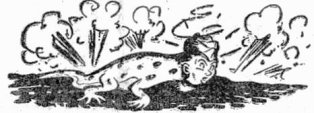
|
Then someone shouted, "Here they come!" and I executed a strategic withdrawal according to plan into my ditch, longing wistfully for the powers of a chameleon. There I pondered on the hollowness of Man's claim to being the biggest cheese in the universe.
At its lightest whim any chameleon could have done a better job at the bottom of that ditch than I did. It could have made itself look like clay or perhaps a pool of water or something else equally deluding to the Japs. I did my damnedest, but all I managed to resemble was something about as inconspicuous as the Statue of Liberty in a khaki uniform. I felt as obvious as a hare-lip.
I never fully realized before what a huge mass a five-foot nine-inch, 140-pound pile of skin and bones can be. But don't get me wrong. I wasn't scared. N-NO SIRee!
If there were a League of Nations, for a barrel of Chinese currency (i.e., $.02) I'd swear out a warrant against the Japs for their inhumane and barbarous methods of waging war. First they tried to annoy us to death with a raid that did little damage to us, but cost them a fleet of planes; then they tried to make us laugh ourselves to death at fantastic claims over the Tokyo radio that they have annihilated us again.
That's fiendish cunning. After the anguish leaves our poor, aching sides, we begin to brood over the fact that in the Japanese slant-eyed vision of the Cosmos we have been obliterated. Here I am like a certain noted Venetian businessman, possessed of all the physical characteristics of other men, yet in Nipponese eyes I'm a crooked goose... I don't exist any more. A man could easily blow his cork mulling over such double-talk.
I will write you again after our next annihilation.
- Non-existently yours, T/4 WILLIAM GOULD, 14th U.S. Air Force
FIRST MASS HELD ON LEDO ROAD
|
Coincidental with the recent announcement of the "Ledo Road" project, is this picture of the first Catholic Sunday Mass ever held out in the mountains, along the torturous, winding highway, Oct. 10.
Men from several units of this jungle neighborhood gathered to hear Father Edmund Fleming, Army Chaplain, of Worcester, Mass., say a late afternoon mass, as the lengthening shadows indicate.
Eddie Pepper, of Cleveland, Ohio, played a portable field organ which was loaned for the occasion by a Protestant Chaplain "down the road." Jimmy McCoy, also of Cleveland, served the priest at mass.
Heretofore, out in the hills, the only Catholic services were those held, twice a month, on weekdays, on visits from Father Louis J. Meyer, of Philadelphia, who would travel out along the road as far as weather and conditions would permit.
Roundup readers in the photograph include: John Ballas, Portland, Ore.; Arthur Repenshek, Sheboygan, Wis.; Fred G. Hof, Woodmere, N.Y.; Hozie Gatson, Strong, Ark.
'Jive Bombers' Hit Symphonic Heights At India Air Base
By Pfc. ED FREY
CENTRAL INDIA AIR DEPOT - Biggest news for the G.I.'s at this air depot in months is the announcement by Special Services of our new modern 12-piece dance band, to be called the "Jive Bombers."
The band will give concerts, play at all Depot social functions and blare forth at the officers' mess every Saturday night. New instruments have been furnished by Special Service and it is reported that this is the only such kit in the Theater. Sgt. Gunn, of SSO, says the musicians will be plenty busy in the months ahead.
Privates, Corporals and "one stripers" had their night here recently when the Red Cross sponsored a dance for the lower three grades. Entertainment was furnished by the Top Hat Trio, composed of Bill Mathias, Victor Gunn and Troy Corley; solos by Emory Stone, several violin numbers by Miss Benita Mossman, ARC, and a dancing contest which was won by Aubrey Dickey and his partner, Miss Edith Sweeney.
The next dance will be for the sergeants, so don't fret, boys.
|
By Pvt. AL ROTH
ASSAM AIR BASE - Entertainment, even if produced by the local talent, is better than no entertainment at all, and recently a musical revue was formed here that has turned out to be something superior in the matter of breaking the monotony of war in the Assam hills.
Known as "Hump Happy," the show was thrown together primarily for this camp but after it had been so enthusiastically enjoyed here, Capt. Clark Robinson, Special Service Officer, received requests from many neighboring camps and now the boys are going "on tour," traveling with the good wishes of high-ranking commanders.
Red Cross assistance came from Kate Lawson, a former actress of the stage and screen, as costumes, curtains and other equipment were donated to the troupers.
Among the highlights of the show are Madame Slaperbelli and her dancing manikins, displaying what the well-dressed lady of Assam will wear this season. Climaxing this act is a strip-tease by Cpl. John Sydow, guaranteed to make you
|
Another feature is the sensational impersonation of the Andrews sisters with S/Sgt. John Cobb, Cpl. Sydow and Sgt. Hupfel doing the lyrics.
Other members of the cast are: John Newman, operatic tenor; Cpl. Winston Wenig, the G.I.'s "Frank Sinatra"; Sgt. Fagin, whose impersonation of female roles causes many "an eyebrow to whistle"; S/Sgt. Dalton Savage and Pvt. Robert McCullum, who bring back memories of the wild west with their cowboy classics and the very rhythmic G.I. orchestra, which travels with the troupe.
Al Roth, a veteran of professional experience, is stage manager and director of "Hump Happy," the show that's making the G.I. citizens of Assam roll in their seats.
|
One of the barracks of the Air Force here in Delhi is known as "Little Bayonne" for here amidst thatch-roofed bamboo huts, camel and ox carts, and Hershey kiss-topped government buildings live thirty G.I.'s, all of whom call Bayonne, N.J. their home town. Speaking on a transcription made by the C-B-I Radio Team at Duration Den recently, the boys told the folks back in Jersey, that "Jersey was never like this," and made a special appeal to the mayor for beer and pretzels. Reading from left to right in the picture, Front row: Sgt. Thomas McGlynn, S/Sgt. Ed Kelly, Sgt. Mat Secunda, Sgt. Jackson Kassover, Pvt. Harold Holmes and Cpl. Frank Woods. Second row: Cpl. Babe Solecki, Pfc. John Uldrich, Sgt. Charles Budjinski, Pvt. Nicholas Barresi, Cpl. John Fimeola and Sgt. Peter Kurpul. Third row: Cpl. Matt Kaminski, Cpl. James McCulligan, Sgt. Aaron Swift.
Heigh-Ho, Silver!
G.I. BLASTS INDIAN BUSES
(In a recent issue of the Roundup, we made a few remarks about Indian train service. Now, one of our own staff members, just back from a bus trip, rises to tell us that until we've taken a trip on Indian buses we ain't seen nothing. - Ye Ed.)
By S/Sgt. WILLIAM E. BARNUM Roundup Staff Writer
Travel by rail may be a bit on the rough side in the so-called Land of Mystery, but reading about it brings no tears to the eyes of any khaki-clad laddie who has gone anywhere in India by bus. To anyone who has enjoyed the comforts and speed of the super buses in the States, covering 300 miles in India by bus in 48 hours - less nine for sleep in an Indian settlement - is a bit trying, to say the least.
The buses take one back to the days of Heigh-Ho Silver, Death Valley and the Era of the Stage Coach. As a matter of fact, the stage coaches undoubtedly were more comfortable. Traveling on said bus is an experience, an interesting one, but one very few would want to repeat.
To begin with, like Indian trains, the bus never starts on time. After a hectic time trying to settle the ticket and reservation matter with the checker and listening to other passengers, mostly Indians, fire at will in Indian lingo at the cahier, the tedious job of loading bags, sleeping rolls, fruit, food and a dozen other articles on top of the already shaking bus begins.
This goes on from sunrise until some hours later. Your baggage is loaded, unloaded and reloaded. The next step is to crowd the passengers into the vehicle without causing a revolution. After all is well, you sit in the bus for at least an hour before the driver decides either to get someone to crank or push in order to start the motor. At long last, the journey begins.
The old bus puffs along at the tremendous rate of 25 or 30 miles an hour at best. As gasoline is scarce, the driver turns off the juice frequently and floats along until the modernized buckboard is almost at a standstill.
Traveling through the mountains, where the "roads" are no bigger than goat paths, you speed along at about 10 miles or less an hour. However, the scenery is worth seeing. As the bus started several hours late, and is losing time along the way, often you wind up at the end of the day in a little Indian settlement where there are a couple of shacks and nothing to eat but an old fashioned version of a pancake.
After a rather strange night listening to Indian music and dogs fight in an atmosphere that might have existed a couple hundred of years ago, you start on your weary way at the crack of dawn with no breakfast.
At weak bridges, you walk across and pray that the bus, carrying a good portion of your belongings, will make it to the other side. Then comes the changing of buses. Usually to a worse one than before. If you get a coal burning bus, your troubles have just begun. You start out at a rapid 13 miles an hour, and hope. But your hope is all in vain. Soon the bus puffs, smokes, rattles and comes to a dead stop. After a lengthy consultation, the driver decides he will fire up the coal burner.
When this is done, the next feat is to start the motor. As the battery is too weak and the crank does no good, pushing is the only answer. After not too much success, you get out and push, too. You were scheduled to arrive at 9 p.m. and it is now midnight. At three in the morning, the driver is tired. The bus breaks down again and

|
You rouse him then and get him to work on the coal burner. After many more attempts, you do more pushing and the bus starts. You have not had any food since the afternoon before. At 10 in the morning you arrive at your destination. You have covered the last 100 miles in 13 hours.
As most of the passengers complain often to the bus company, the officials are used to it by now and all they can offer is a meek, "Very sorry, Sahib. It was a mistake. Next time it will be better."
'Tis strictly for chuckles, but what worried us is - we aren't doing the chuckling.
TERRIFIC DOINGS CELEBRATE POSHY NEW SERVICE CLUB
By Cpl. ROBERT AYLWARD
INDIA BASE - After months of anticipation and weeks of delays, we opened our new club, the poshest on-post institution in Mother India, and christened it with a gala stage show. No one swung a bottle at anyone else's prow, and the only liquid refreshment was the juice of the ever-present lime. But Joe Dogface was there en masse, and the general consensus seemed to be that when they could provide a setup like the new service club, the Red Cross must be "Tik Hai."
Jack Conway was here is person to turn the keys over to the Post Commander, and after a commendably short series of speeches, the program rolled into high gear. Knowing that soldiers get pretty sick of seeing other GI's perform, we combed the countryside for new faces, and with extraordinary good luck. For we unearthed a master of ceremonies who would have literally laid the audience in the aisles, except that there wasn't an inch of extra space. Gypsy Rose Lee herself never had a fuller house.
Perhaps the most professional thing in the whole show was the performance of Lewin Brown, dancer extraordinary, who ran the gamut from Carmen Miranda to a Hindu Tribal dance with amazing ease and talent. Besides him, out of the tropical topee we pulled a first-rate magician.
But of course we couldn't resist showing off our own peculiar brand of corn to so big an audience, so we whipped up a little gem of backwoods drammer in the best Tobacco Road tradition. We enlisted the talents of Janet Carey, new club director and one of the current crop of glamour gals here, but after we had black out a couple of her teeth, dirtied her face, top-knotted her curls, put GI boots on her, and then stuck a corncob pipe in her mouth, there wasn't an ounce of glamour left, by gum. But she did real well, and even reached an unexpected climax when the wicker basket on which she was sitting gave way and let her down literally.
After a succession of darned good acts, including a Yogi exhibition of muscle control that left the audience with their eyes popping, the show finally ended with Roy Brodsky's popular and singable "CONTACT, U.S.A."
The C.B.I. Roundup is a weekly newspaper published by and for the men of the United States Army Forces in China, Burma, and India, from news and pictures supplied by staff members, soldier correspondents, the United Press, and the War Department. The Roundup is published Friday of each week and is printed by The Statesman in New Delhi, India. Editorial matter should be sent directly to Lt. Floyd Walter, Rear Echelon Hq., U.S.A.F., C.B.I., New Delhi, and should arrive not later than Monday in order to make that week's issue. Pictures must arrive by Sunday and must be negatives or enlargements. Stories should contain full name and organization of sender.

OCTOBER 29, 1943
Original issue of C.B.I. Roundup shared by Ruth Canney, widow of CBI veteran John Canney.
Copyright © 2007 Carl Warren Weidenburner
TOP OF PAGE PRINT THIS PAGE ABOUT THIS PAGE SEND COMMENTS
PREVIOUS ISSUE CLOSE THIS WINDOW NEXT ISSUE
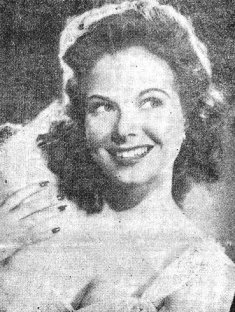 We present this week radio actress Cheer Brentson, who could be any nice girl in anybody's home town, dressed up for a Saturday night party.
We present this week radio actress Cheer Brentson, who could be any nice girl in anybody's home town, dressed up for a Saturday night party.
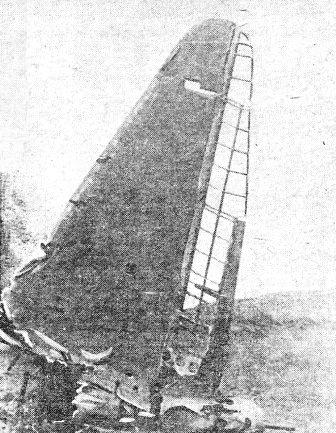 This lone airplane wing represents a monument to the folly of Japanese aerial raiders who braved the wrath of
U.S. P-38's and P-40's in a recent raid on a 14th Air Force airbase. Forlornly it points to the China sky
from which it and 16 other Nip planes, 15 of them bombers, were shot down in the battle. Seven other bombers
and two more fighters were probably destroyed. All American planes and crew members returned safely.
This lone airplane wing represents a monument to the folly of Japanese aerial raiders who braved the wrath of
U.S. P-38's and P-40's in a recent raid on a 14th Air Force airbase. Forlornly it points to the China sky
from which it and 16 other Nip planes, 15 of them bombers, were shot down in the battle. Seven other bombers
and two more fighters were probably destroyed. All American planes and crew members returned safely.
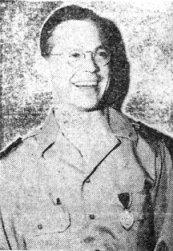

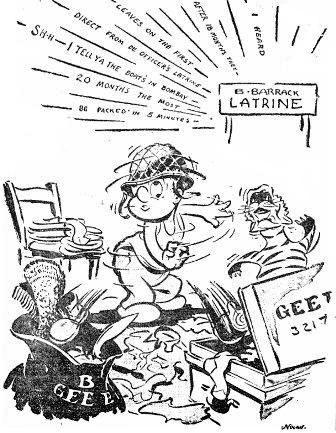
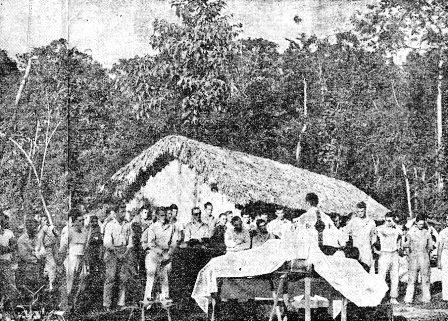
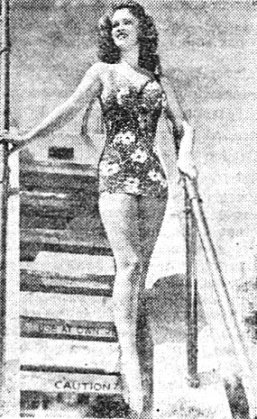 For morale-building purposes, this picture of Frances Rafferty is published to show G.I.'s what the healthful
sport of swimming can accomplish for the human physique. She was once a 97-pound weakling - before she got
her growth.
For morale-building purposes, this picture of Frances Rafferty is published to show G.I.'s what the healthful
sport of swimming can accomplish for the human physique. She was once a 97-pound weakling - before she got
her growth.
